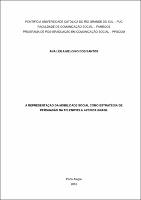| Compartilhe o registro |


|
Use este identificador para citar ou linkar para este item:
https://tede2.pucrs.br/tede2/handle/tede/7165Registro completo de metadados
| Campo DC | Valor | Idioma |
|---|---|---|
| dc.creator | Santos, Ana Leila Melonio dos | - |
| dc.creator.Lattes | http://buscatextual.cnpq.br/buscatextual/visualizacv.do?id=K4290904J8 | por |
| dc.contributor.advisor1 | Haussen, Doris Fagundes | - |
| dc.contributor.advisor1Lattes | http://buscatextual.cnpq.br/buscatextual/visualizacv.do?id=K4783274E2 | por |
| dc.date.accessioned | 2017-03-17T12:07:24Z | - |
| dc.date.issued | 2016-12-13 | - |
| dc.identifier.uri | http://tede2.pucrs.br/tede2/handle/tede/7165 | - |
| dc.description.resumo | Esta pesquisa tem como objeto de estudo a representação da mobilidade social como estratégia de persuasão na teledramaturgia brasileira. Para tal, analisa-se a presença da chamada nova classe média na telenovela Avenida Brasil. A partir das mudanças socioeconômicas ocorridas no país, na década de 1990, demonstra-se como a Rede Globo apresentou a chamada nova classe média, a partir da análise das estratégias narrativas da telenovela quantos aos efeitos do real e o estabelecimento de vínculos da narrativa com o público. Discutiram-se os aspectos socioculturais que a narrativa apresenta, visando estabelecer vínculos com o telespectador e, assim, captar a atenção para trama. O percurso metodológico alicerçou-se nas categorias da retórica (mostração, interação e sedução) a partir de Pinto (1999), conjugadas às técnicas de: estranhamento, entranhamento e desentranhamento de Silva (2011), em convergência com a análise de conteúdo. O estudo desvenda o processo de persuasão da trama, no entrelaçamento da ficção com a realidade, quando se evidencia fortemente a ascensão social e o estilo de vida de uma suposta “nova classe média brasileira” emergente, não como resultado de uma mudança estrutural na sociedade brasileira, mas como uma estratégia retórica que, combinada com uma fabulação bem construída, mesclou elementos clássicos do folhetim tradicional com inovações dramáticas e técnicas que deram verossimilhança à trama, pelo incremento de novos recursos narrativos. | por |
| dc.description.abstract | This research has as object of study the representation of social mobility as a persuasion strategy in Brazilian soap operas. To this end, we analyze the presence of the new middle class in Brazil Avenue Soap Opera. From the socio-economic changes in the country, in the 1990s, it is shown as the Globo TV, presented the new middle class, from the analysis of the soap opera narrative strategies how to real effects and the establishment of narrative links with the public. Were discussed sociocultural aspects that narrative features, to establish links with the viewer and thus attract attention to the plot. The methodological approach its foundations is the rhetoric of categories (mostração, interaction and seduction) from Pinto (1999), the combined techniques: estrangement, entrainment and withdrawal of Silva (2011), in convergence with the content analysis. The study uncovers the process of persuasion of the plot, the interweaving of fiction with reality, when it strongly emphasizes the social rise and the lifestyle of a supposed “new Brazilian middle class” emerging, not as a result of a structural change in society Brazilian, but as a rhetorical strategy that, combined with a well-constructed fictions, blended classic elements of the traditional broadsheet with dramatic and technical innovations that give verisimilitude to the plot, the increase of new narrative resources. | eng |
| dc.description.provenance | Submitted by Setor de Tratamento da Informação - BC/PUCRS ([email protected]) on 2017-03-17T12:07:23Z No. of bitstreams: 1 TES_ANA_LEILA_MELONIO_DOS_SANTOS_COMPLETO.pdf: 3258396 bytes, checksum: 92a6c4985dc3e55c48fe4e26a712702d (MD5) | eng |
| dc.description.provenance | Made available in DSpace on 2017-03-17T12:07:24Z (GMT). No. of bitstreams: 1 TES_ANA_LEILA_MELONIO_DOS_SANTOS_COMPLETO.pdf: 3258396 bytes, checksum: 92a6c4985dc3e55c48fe4e26a712702d (MD5) Previous issue date: 2016-12-13 | eng |
| dc.format | application/pdf | * |
| dc.thumbnail.url | http://tede2.pucrs.br:80/tede2/retrieve/167500/TES_ANA_LEILA_MELONIO_DOS_SANTOS_COMPLETO.pdf.jpg | * |
| dc.language | por | por |
| dc.publisher | Pontifícia Universidade Católica do Rio Grande do Sul | por |
| dc.publisher.department | Faculdade de Comunicação Social | por |
| dc.publisher.country | Brasil | por |
| dc.publisher.initials | PUCRS | por |
| dc.publisher.program | Programa de Pós-Graduação em Comunicação Social | por |
| dc.rights | Acesso Aberto | por |
| dc.subject | MOBILIDADE SOCIAL - BRASIL | por |
| dc.subject | TELENOVELAS - BRASIL - HISTÓRIA | por |
| dc.subject | COMUNICAÇÃO SOCIAL | por |
| dc.subject.cnpq | CIENCIAS SOCIAIS APLICADAS::COMUNICACAO | por |
| dc.title | A representação da mobilidade social como estratégia de persuasão na telenovela Avenida Brasil | por |
| dc.type | Tese | por |
| Aparece nas coleções: | Programa de Pós-Graduação em Comunicação Social | |
Arquivos associados a este item:
| Arquivo | Descrição | Tamanho | Formato | |
|---|---|---|---|---|
| TES_ANA_LEILA_MELONIO_DOS_SANTOS_COMPLETO.pdf | Texto Completo | 3,18 MB | Adobe PDF |  Baixar/Abrir Pré-Visualizar |
Os itens no repositório estão protegidos por copyright, com todos os direitos reservados, salvo quando é indicado o contrário.




